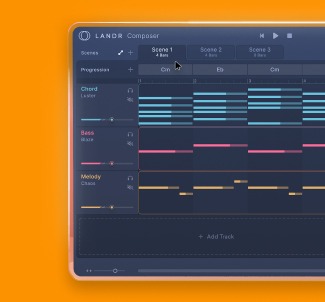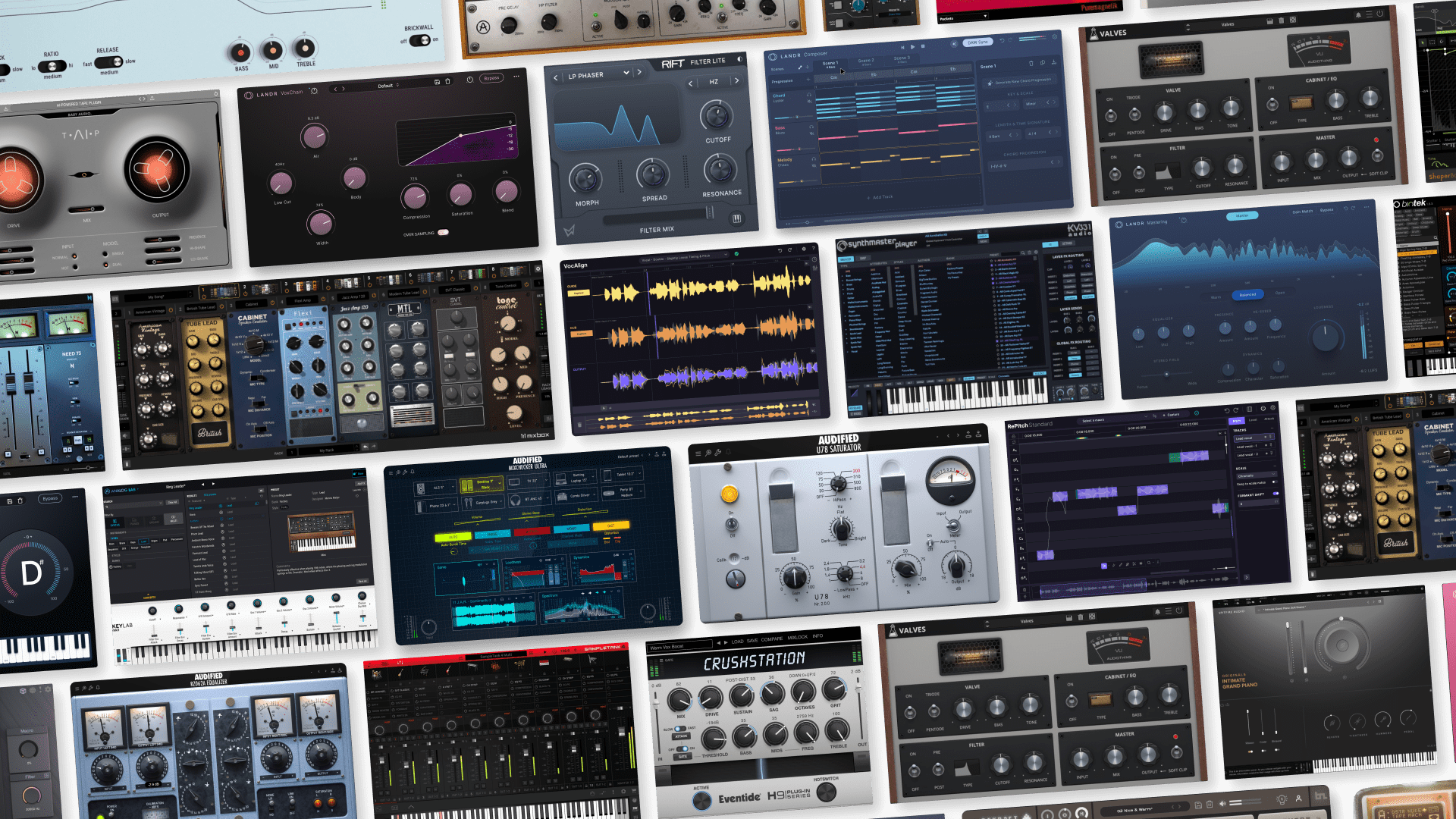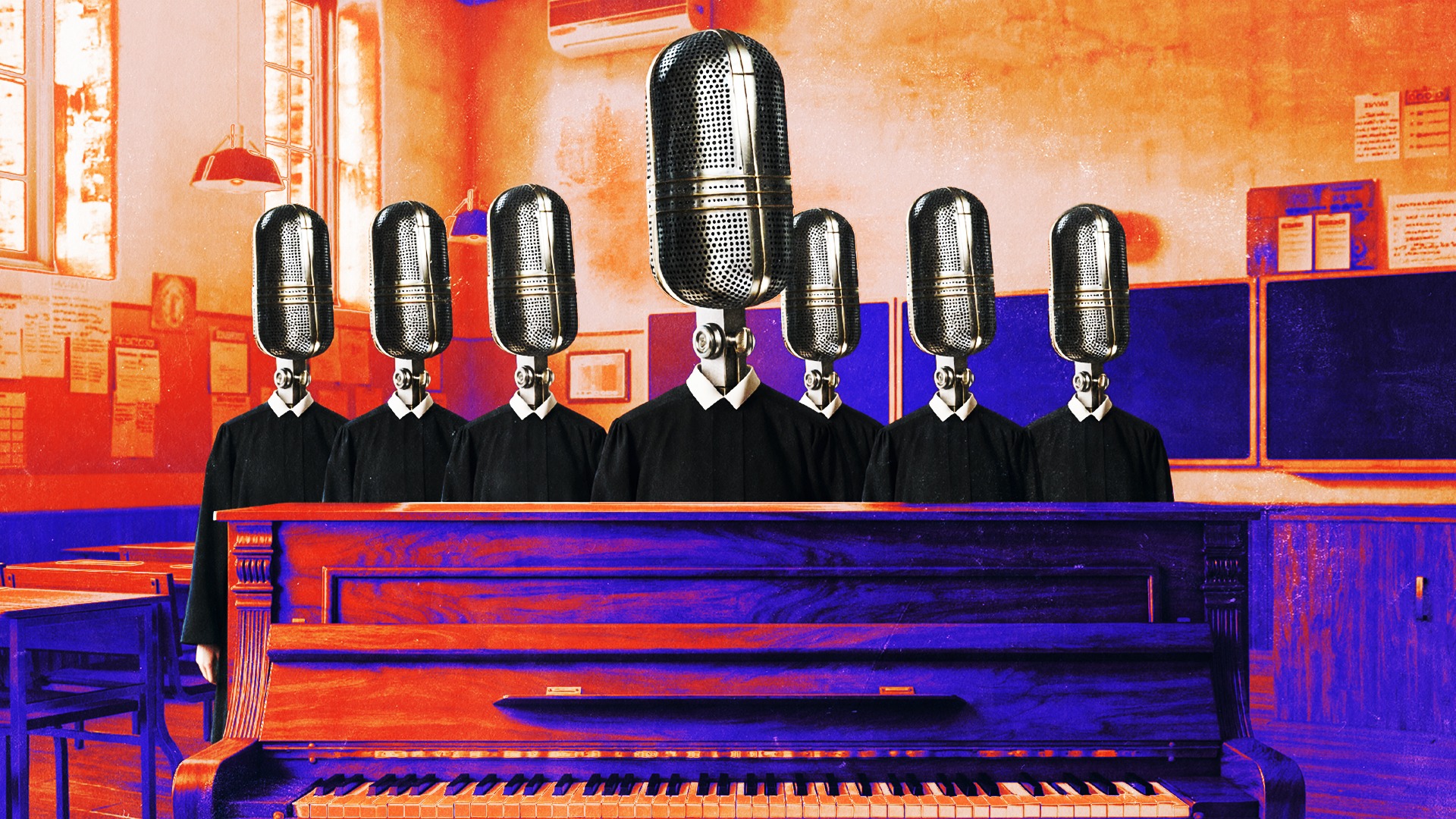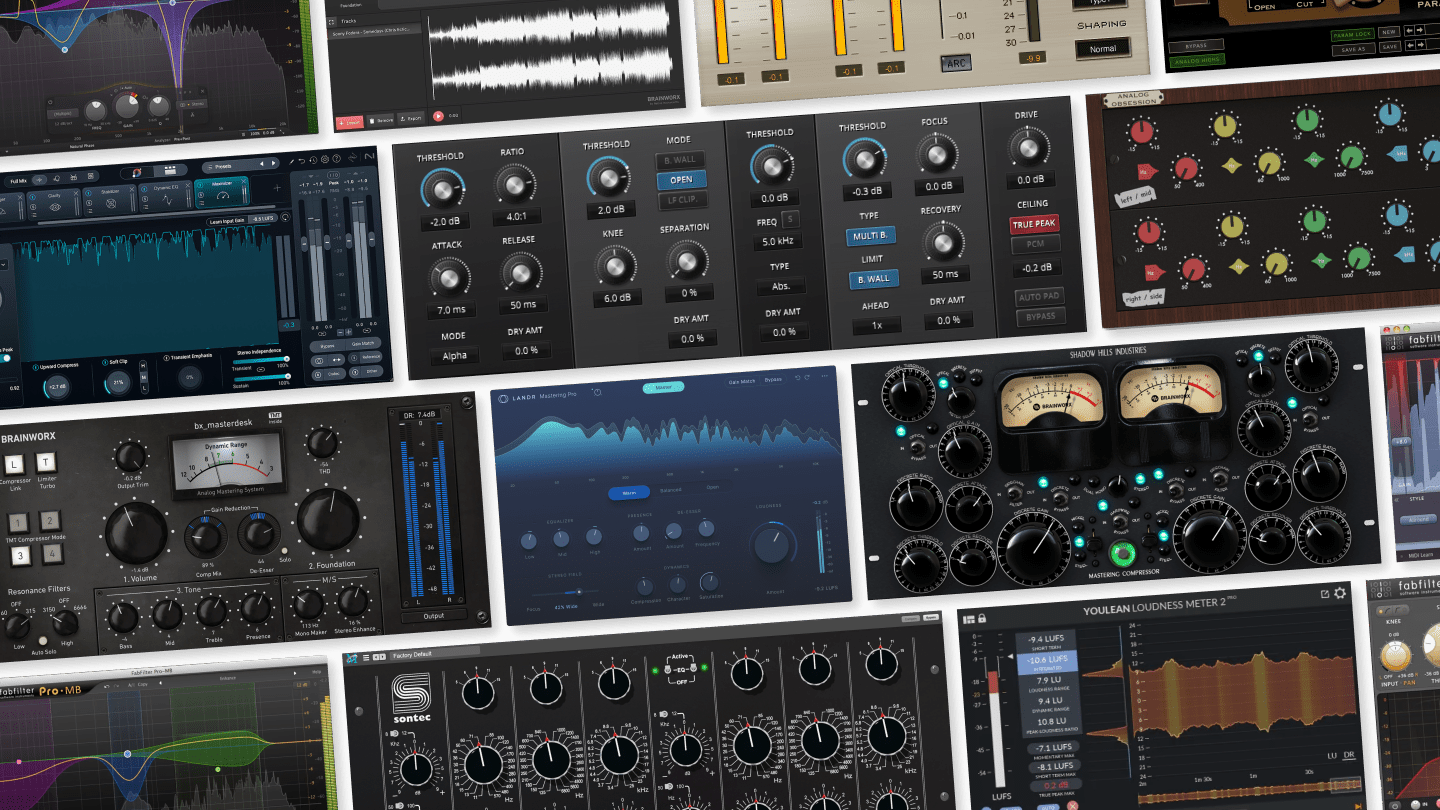
How to Write Chord Progressions: Essential Guide
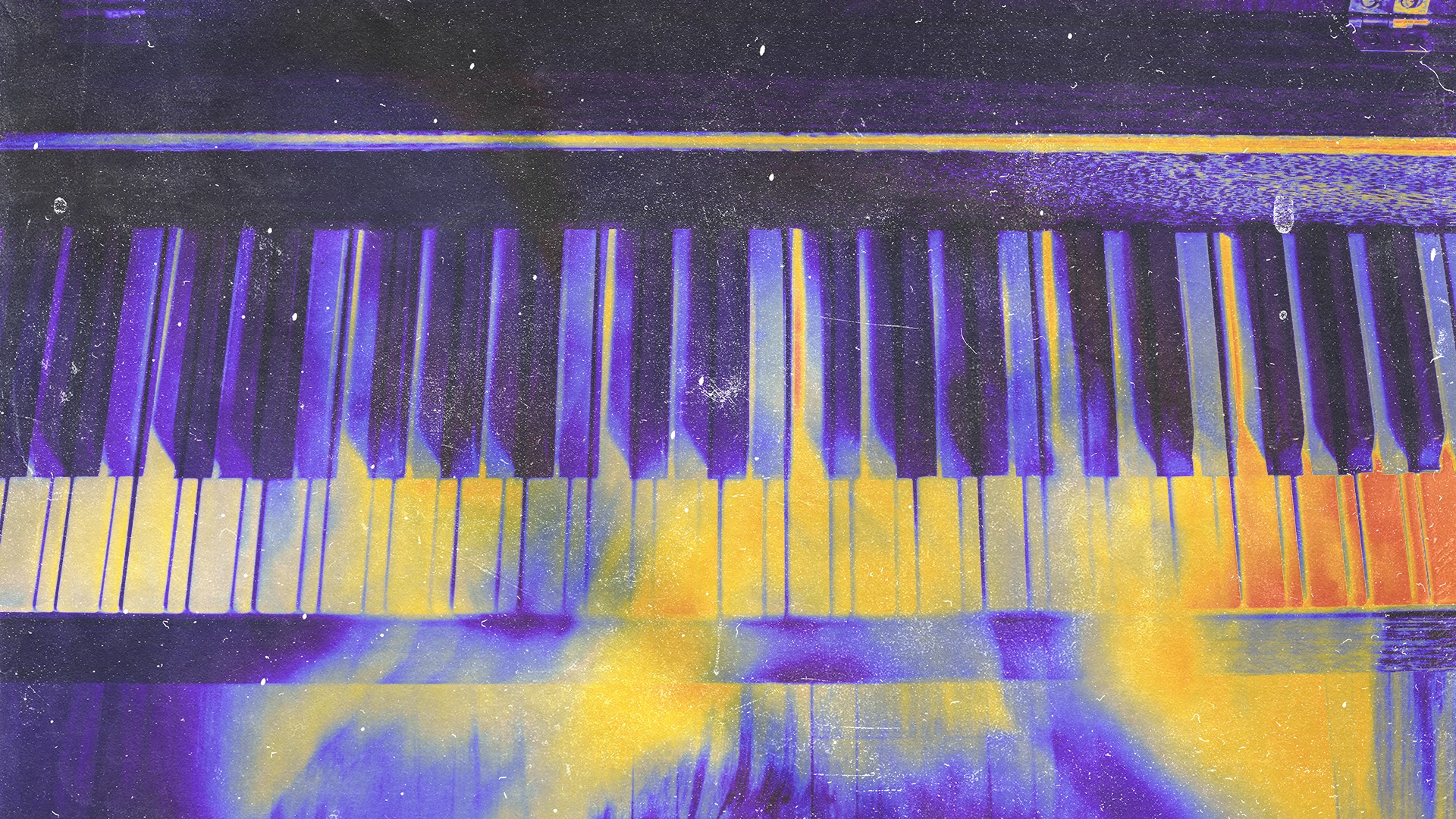
If you’ve ever felt yourself staring at a blank page, wondering how to write chord progressions that sound good and convey meaning, you’re not alone.
Music is a language — it takes practice to learn how to string the right things together to communicate a complete idea.
It’s also why the number one trick for learning how to write chord progressions is to listen to and learn from the music that inspires you.
But aside from immersing yourself in music, practicing your instrument or experimenting in your DAW, there are a few things to consider that will speed up your learning process.
In this article, we’ll dive into everything you need to know about writing great chord progressions and you’ll find a couple of handy tips and tools to help you get started.
1. Learn the diatonic chord scale
The diatonic chord scale is the most fundamental building block when learning how basic chord progressions work.
Building a diatonic scale is easy. Just take a given major or minor scale and build a triad that’s composed of the scale’s root, third and fifth notes on each step of the scale.
These chords define the chords belonging to a scale’s key.
Diatonic chord scales are notated using roman numerals, with upper case numerals indicating a major triad and lower case numerals indicating a minor triad.
With one exception — the triad at the seventh degree of the major scale or second degree of the minor scale (notated as vii° or ii°) is always a diminished triad.
The pattern of major and minor chords found in a major diatonic scale is always: I-ii-iii-IV-V-vi-vii°.
Here’s how a C major diatonic scale looks when notated in C major the musical staff:
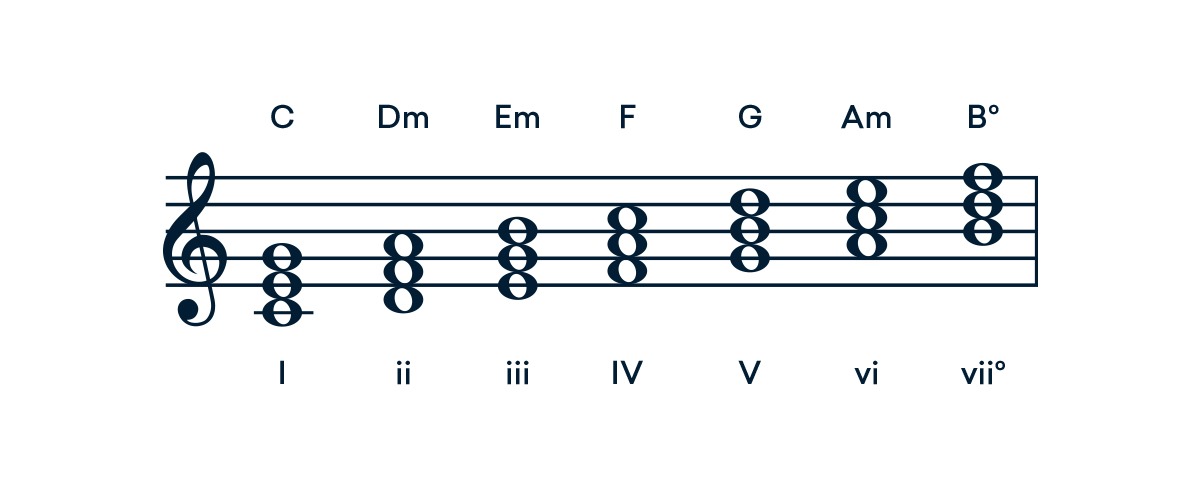
And the pattern of minor chords found in a minor diatonic scale is always: i-ii°-III-iv-v-VI-VII.
Here’s how a minor diatonic scale looks when notated in C major’s relative minor, A minor.
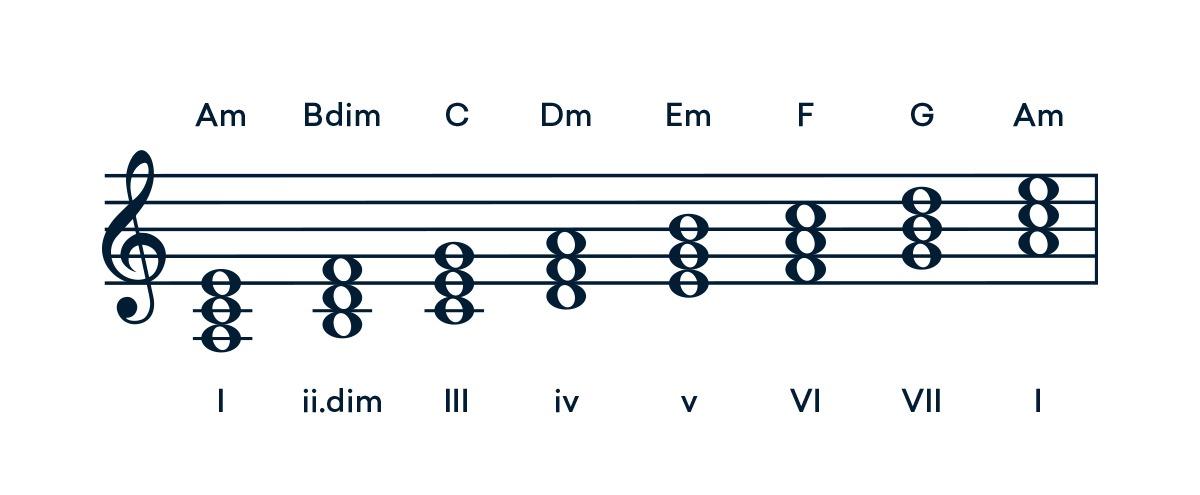
Learning the diatonic scales for each scale gives you the ability to learn all the chords within a given key. Once you know them, writing basic chord progressions that stay in key is almost too easy.
Here’s a breakdown of all the chords in each major key, alongside each relative minor.
Major and minor diatonic chords
| Major | I | ii | iii | IV | V | vi | vii° | |
|---|---|---|---|---|---|---|---|---|
| III | iv | v | VI | VII | i | ii° | Minor | |
| C Major | C | Dm | Em | F | G | Am | Bdim | A Minor |
| Db Major | Db | Ebm | Fm | Gb | Ab | Bbm | Cdim | Bb Minor |
| D Major | D | Em | F#m | G | A | Bm | C#dim | B Minor |
| Eb Major | Eb | Fm | Gm | Ab | Bb | Cm | Ddim | C Minor |
| E Major | E | F#m | G#m | A | B | C#m | D#dim | C# Minor |
| F Major | F | Gm | Am | Bb | C | Dm | Edim | D Minor |
| Gb Major | Gb | Abm | Bbm | B | Db | Ebm | Fdim | D# Minor |
| G Major | G | Am | Bm | C | D | Em | F#dim | E Minor |
| Ab Major | Ab | Bbm | Cm | Db | Eb | Fm | Gdim | F Minor |
| A Major | A | Bm | C#m | D | E | F#m | G#dim | F# Minor |
| Bb Major | Bb | Cm | Dm | Eb | F | Gm | Adim | G Minor |
| B Major | B | C#m | D#m | E | F# | G#m | Bbdim | G# Minor |
2. Loop a simple four-chord progression
Once you know all the chords in the diatonic chord scale, putting together chords from a given key gets much easier.
So many chord progressions in popular music mainly draw chords from the diatonic chord scale with a specific focus on the one, four, five and six chords in both major and minor keys.
We’ve looked at common chord progressions in both major and minor keys in past articles, but here’s a few of the most popular ones heard across genres in tons of popular music.
I-V-vi-IV
Known in some circles as the “doo-wop” chord progression, the I-V-vi-IV chord progression is about as classic as it gets.
You’ll hear it used in everything from early Beatles to modern pop.
Some examples include “Let It Be”, “I Will Always Love You”, “Forever Young”, “Paparazzi”, “Take Me Home, Country Roads” and “Don’t Stop Believing”, to name a select few.
The chord progression uses only diatonic chords and relies on the minor chord found at the sixth degree to create tension before the major four-chord resolves back to the major root chord.
i-VI-III-VII
Minor chord progressions are surprisingly common in pop music. In fact, nearly two-thirds of today’s pop songs written in a minor key.
But if there’s one minor chord progression that’s particularly common in popular music, it’s certainly the i-VI-III-VII chord progression.
You’ll hear it used in songs like “I Miss You” by Blink 182, “Zombie” by The Cranberries and “Apologize” by OneRepublic.
Like the major chord progression we just discussed, the chords are all in key and fall into the minor diatonic scale.
It’s one of many examples of all the chords you’ll discover by learning the diatonic chord scale in each key.
3. Use a chord progression generator
If you haven’t noticed, all the examples in this article have been made with the help of LANDR Composer, a powerful chord generator tool that makes it incredibly easy to create any chord progression.
It has an intuitive design that gives you a ton of options to create a 4 to 32 bar chord loop.
You can even change the arrangement by adding different chord types, inversions and extensions to the chords it generates.
On top of that, Composer can generate basslines and melodies alongside the chords it generates to get your creative juices flowing.
With a ton of great built-in synth sounds and the ability to easily export chords to a new MIDI track for playing any synth plugins you have in your DAW, Composer is a fast track to building new ideas and writing unique and interesting music.
4. Play with inversions
If you noticed that I mentioned LANDR Composer’s ability to add chord inversions to the chords it generates, you might be curious what exactly a chord inversion is.
Luckily we’ve covered chord inversions at length in past articles, however the main point of inversions is to help make chord changes in a chord progression sound more fluid.
By rearranging a triad into its second or third inversion, you can lessen the distance between the notes played in each chord change, creating a much less jarring effect that’s more musical.
LANDR Composer can help make it easier to learn, understand and use inversions in your chord progressions because it makes it easy to hear how they sound in a chord progression without learning all the theory behind them.
So if you want your chord progression to sound more smooth and fluid, consider trying out different inversions between your chord changes.
5. Add flavor with chord extensions
Chord extensions do exactly what their name suggests — they extend triad chords with extra notes to create harmonic complexity that adds tension and release to each chord change.
Triads aren’t exactly the most interesting chords in their basic form. They can sound dull and unmusical if you exclusively use stacked triads in succession.
Extending a chord with a jazzy major 7th or 9th note will help make any chord sound more interesting.
There’s many extensions to explore, especially when you start playing around with different inversions and chord types.
So if you’re curious about what each chord extension can do harmonically, we’ve written past articles that explore the concept in more detail.
Dive into the world of chord progressions
Chord progressions are a multi-faceted part of music making, so it’d be difficult to cover everything about them in one article!
Fortunately, we’ve written a lot about chord progressions on the LANDR Blog.
Here are a few articles to check out if you want to get more in-depth knowledge about a specific aspect or genre of chord progression.
Chord theory
- What are Chord Progressions? How to Use Chords in Music
- Chord Building 101: 4 Basic Chord Types and How to Play Them
- Chord Inversions: How to Write Better Chord Changes
- What are Triads? The Musical Building Blocks of Chords
Common chord progressions
- 7 Common Chord Progressions You’ll Instantly Recognize
- 11 Emotional Chord Progressions Every Producer Should Know
- 8 Minor Chord Progressions for Evocative, Emotional Songwriting
- 8 Cinematic Chord Progressions for Epic, Dreamy Sound
Jazz, soul and gospel chord progressions
- 8 Jazz Chord Progressions Every Musician Should Know
- Gospel Chords: 10 Chords You Need to Play Soulful Gospel Music
- 12 Bar Blues: Basic Blues Chord Progressions Explained
Pop, electronic and hip-hop chord progressions
- Drill Chords: 10 Dark Progressions for Hard Hitting Productions
- Lofi Chord Progressions: 11 Easy Ways to Build Nostalgic Lo-Fi Chords
- 8 House, Techno and EDM Chord Progressions Every Producer Needs
Chord types
- Power Chords: How to Play and Use Music’s Easiest Chord
- Pedal Point: How a Single Bass Note Can Change Your Chords
- Minor Chords: What They Are and When to Use Them
- Major Chords in Music: How to Use the Cheeriest Chord
- Suspended Chords: Create Tension With Sus4 and Sus2
- Secondary Dominants: How To Add Drama To Your Chord Progressions
- Diminished Chords: What They Are and When to Use Them
Make your own chord progression
With all these tools and knowledge at your disposal, you have everything you need to know how to write a chord progression.
Don’t be afraid to experiment, break the rules, and discover your own unique sound.
Whether you’re crafting a simple pop hook or a complex jazz arrangement, a solid understanding of chord progressions will take your music to the next level.
Gear guides, tips, tutorials, inspiration and more—delivered weekly.
Keep up with the LANDR Blog.


